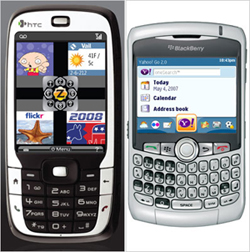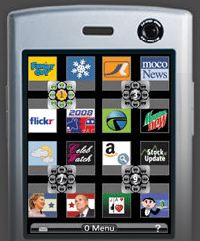 Three recent posts on the Web discuss the coming of the Mobile Web. One thing we can all agree on: It’s a big deal. What we don’t agree on is this: When will it get here, and will it be what we as consumers need?
Three recent posts on the Web discuss the coming of the Mobile Web. One thing we can all agree on: It’s a big deal. What we don’t agree on is this: When will it get here, and will it be what we as consumers need?
The Register recently conducted a poll of its readers with more than half believing that “always-on mobile Internet access” will become “fundamental” to how they work. Recognizing that its poll is skewed — techies read the “publication”, not my insurance-salesman neighbor — The Register nonetheless rightly notes that once availability, accessibility, traffic structures, hardware, and other issues are sorted out the Mobile Web will finally arrive.
“When the technology passes the always-on threshold,” The Register writes, “you can expect people to use it with impunity.”
Which brings me to my second bit of news.
 Yahoo! says the mobile Internet will overtake fixed Internet use in 10 years, according to a report in Total Telecom. That seems a bit industrious, considering that the Mobile Web isn’t even here yet, but it makes sense when considering developing countries.
Yahoo! says the mobile Internet will overtake fixed Internet use in 10 years, according to a report in Total Telecom. That seems a bit industrious, considering that the Mobile Web isn’t even here yet, but it makes sense when considering developing countries.
“Within 10 years more people will be accessing the Internet from their mobile . . . than in the home from a PC,” said Geraldine Wilson, vice president of connected life at Yahoo! Europe. “In emerging markets most people’s first contact with the Internet will be with a mobile phone.”
Speaking at a presentation in London last week, Wilson stated the obvious: the cost of mobile data services must come down, handsets need better interfaces, and network speeds must improve to drive uptake.
“We have to be careful because there have been many false dawns of the Internet on mobile,” she said, “but I think we will look back at 2007 as when things started to happen.”
Wilson might be right. Michael Fitzgerald just published an insightful “State Of” piece on the Mobile Web in The New York Times, noting that in 2007 we’ve seen the introduction of the iPhone, more than 30 companies signing up for Google’s Open Handset Alliance, and Nokia snapping up Web technology companies at an alarming rate, including an $8.1 billion bid for Navteq, a digital mapping service.
As the NYT notes, the Mobile Web is “so close yet so far.”
 Third-generation networks (3G) were supposed to be the answer to high-speed cellular networks, but at a recent conference Carolina Gabriel, an analyst with Rethink Research, called 3G “a failure”. Another survey, conducted by Boston research firm Yankee Group, shows that only 13 percent of cellphone users in the U.S. use their phones to access the Web more than once a month, while 70 percent of computers users view Web sites daily.
Third-generation networks (3G) were supposed to be the answer to high-speed cellular networks, but at a recent conference Carolina Gabriel, an analyst with Rethink Research, called 3G “a failure”. Another survey, conducted by Boston research firm Yankee Group, shows that only 13 percent of cellphone users in the U.S. use their phones to access the Web more than once a month, while 70 percent of computers users view Web sites daily.
Cellphones with Zumobi software and Yahoo! Go are mobile surfing services, but many people are not using them.
“For now, widespread use of the mobile Web remains both far off and inevitable,” Fitzgerald writes.
Photo credit: Of Zumobi software and Yahoo! Go, New York Times.

This is very interesting 😀
Why are people still claiming there are technology hurdles to a mobile web? Have you ever been to Asia? Koreans and Japanese use their mobile phones to browse the web, many of them don’t even have a computer.
We’re not missing technology, we’re missing the services.
Here in Europe we already get unlimited HSDPA access for like $10 a month. Get a Samsung F700 with it and the device isnt a problem anymore either.
America is staying behind with mobile technology. But America, my friends, is not the world.
I have to agree with Bosmonster. I live in Sweden and I’ve got unlimited 4 mbit/sec internet on my phone and use it extensively when I’m not at home. I can stream video and music from my home computer (see http://www.orb.com) and pretty much do anything related to the web that I could on my home computer. I can take 5 megapixel photos with my phone (it’s an N95) and upload them to a community website with one click in just a few seconds.
Personally I believe that mobile phones will replace computers entirely. In 15-20 years you will put your “mobile phone” next to any monitor and it will automatically connect to the monitor. It could also connect to a wireless keyboard and mouse. Then you’d have the same comfortability you have in front of a computer today while keeping the functionality on a device that you can bring with you at all times.
For those of you interested in building mobile specific web applications check out http://www.amethon.com or more specifically http://www.amethon.com/Content_Common/pg-Port-Analytics.seo
As some or most of you already know, desktop analytics dont work with mobile browsers, leaving developers to fly blind or resort to messy and inaccurate log file analysis.
Amethon Mobile Portal Analytics is an application designed to work specifically with mobile browser interactions.
Of course not knowing this wont hurt your application but flying blind is foolish, plus being able to provide accurate information increases your ability to monetise your application to the fullest and make sure that website visitors are using your content rather than just hoping they seeing what you think they are seeing.
Cheers,
Dean.Collins@amethon.com
Mobile Internet in my opinion will take another 20 – 30 years to catch up with the real Internet. Maybe with the introduction of Google’s Android mobile OS it can be cut to about 10 -15 years. The mobile phone industry is run by greedy companies who value profits rather than customer experience.
Andreas comment made me laugh about it being 15-20 years until a phone can connect wirelessly to TV, keyboard and mouse. Obviously he has yet to open his N95 manual 😉 which can do all of these things (well the S60 OS doesn’t support a mouse as standard, but it’s technically possible). The rest is here now and people have been using them for some time. The N95 incidentally has sold over a million in the UK alone.
Alfred Saforo is also way out (20-30 years!!?). More like 20-30 weeks is a bit more realistic. This whole article seems very uninformed of the extent of mobile web/internet usage across the rest of the planet. The US is well known for being significantly behind the world (particularly Europe and Asia) in usage, services, and general outlook on mobiles. No wonder iPhone was such a wet dream for all of you 😉 If you consider mobile web access (whether sites are built for mobile or not) in a lot of countries mobile access exceeds fixed line access or is drawing near to it. As TV out (wired or wireless) becomes a regular fixture on phones, they will increasingly become used for … well, just about everything. Already on an N95 (or N82 etc) you have full office suites, games to rival the Playstation 1 or better, full internet browsers, you name it.
If you’re in the US try popping over to other developed countries, and see what you’re missing out on in mobile!
Read and replied to on an iPhone 🙂
I think the mobile Internet will start where all emerging technologies start – with the geeks. They’ll make the case that it is a necessary tool in everyday life. But we’re still not quite there yet. Even now, what with the rapid adoption of devices like the BlackBerry and the iPhone and HTC’s new devices, the mass market still isn’t ready for a broad adoption of the mobile Internet, especially in America. I personally envy those in Asia and Europe for the mobile speeds that are available to them, but I still wonder how much of the population actually utilizes those services on a regular basis. I’d venture to guess that its probably about the same percentage as the Americas, but alas I’m ignorant of the European market and its numbers, so that’s just me guessing.
I think the other barrier to mainstream adoption is ease of use – while many devices (such as the Pearl, of which I am a previous owner) are definitely useable for web browsing, I think the main market is still the tech savvy – put the Pearl in my mom’s hands and see how quickly she gives up. But with a new wave of devices that are far more intuitive, the barrier to entry will become lower and lower allowing for more mass market adoption.
I use the web on my crappy phone, however everytime I get a phone such as a blackberry or palm I stop using it because the only option is $30 with ATT. I can’t even send mms or view the web on my blackberry because its locked down unless you pay the $30 monthly fee. That’s outrageous, they don’t even have smaller plans anymore.
I use RocketShotz on my phone (www.rocketshotz.com or rktsz.com from my phone) for mobile web sites. I didn’t have to install anything either. Its really easy to use and my mom likes it too. I can’t even get her to txt me but she will use this service on her phone.
You go to the web site and pick the sites that you want to see on your phone, then it txts you with a web page and you make that your new home page. i can now get to all of my favorites on my phone without having to type anything or search for web sites. I can even choose new sites from my phone too. i’ve got a crappy flip phone but its supposed to work on iphone too.
http://www.bywifi.com is a good mobile website.
1. Provide searching, saving and realtime transcoding 3GP video services for mobile phones.
2. Optimizes Web pages for mobile phones, providing a richer browsing experience.